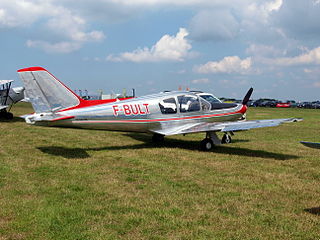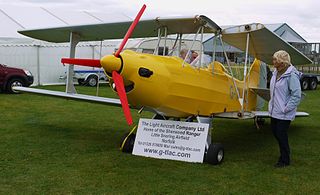
The Pitts Special is a series of light aerobatic biplanes designed by Curtis Pitts. It has accumulated many competition wins since its first flight in 1944. The Pitts biplanes dominated world aerobatic competition in the 1960s and 1970s and, even today, remain potent competition aircraft in the lower categories.

The Taylor Titch is a British fixed-wing homebuilt aircraft, developed in the 1960s by J.F. Taylor. As of 2015, examples are still being built and flown.

The Rollason Beta was a British midget racing monoplane developed from a competition to build a Formula One air racer in the 1960s in England. The Beta was first flown on 21 April 1967. The aircraft were successful air-racers in England during the late 1960s and early 1970s.

The Flying Flea is a large family of light homebuilt aircraft first flown in 1933.

The de Havilland DH.60 Moth is a 1920s British two-seat touring and training aircraft that was developed into a series of aircraft by the de Havilland Aircraft Company.

The Tipsy Nipper T.66 is an aerobatic light aircraft, developed in 1952 by Ernest Oscar Tips of Avions Fairey at Gosselies in Belgium. It was designed to be easy to fly, cheap to buy and cheap to maintain. It was designed for both factory production and homebuild. "Nipper" was the nickname of Ernest Tips' first grandchild.

The Jodel D.11 is a French two-seat monoplane designed and developed by Société Avions Jodel in response to a French government request for a low-wing aircraft for use by the nation's many emerging flying clubs.

The Beagle Husky was a three-seat British light aircraft built in the 1960s which originated from a Portuguese Air Force requirement for a liaison/training aircraft, a development of the Auster Alpha. It first flew as an Auster design in January 1960, but that company was taken over by Beagle Aircraft in September that year. It was initially available with a 160 hp Lycoming O-320 engine as the Auster D5/160.

The Luton L.A.4 Minor was a 1930s British single-seat high-wing ultra-light aircraft. The prototype was built by the Luton Aircraft Limited, and design plans were later adapted and copies sold for homebuilding.

The CAB GY-20 Minicab is a two-seat light aircraft designed by Yves Gardan and built in France by Construction Aeronautiques du Bearn (CAB) in the years immediately following World War II. CAB was formed in 1948 by Yves Gardan, Max Lapoerte and M. Dubouts.

The Sonerai is a small, VW-powered homebuilt aircraft, designed by John Monnett. The Sonerai began to compete as a single-seat, mid-wing, tailwheel Formula-V racer class formed in 1972. The Sonerai soon evolved into a two-seat model called the Sonerai II.

The Piel CP-30 Emeraude is an aircraft designed in France in the mid-1950s and widely built both by factories and homebuilders.

The Druine D.60 Condor is a light aircraft designed by Roger Druine in France in the 1950s. Druine’s primary aim was to design a trainer aircraft for amateur construction. The Condor was subsequently made in quantity in the UK by Rollason Aircraft & Engines.
Rollason Aircraft and Engines Limited was a British aircraft manufacturer and aircraft maintenance and refurbishment company from its formation in 1957.

The Procaer F.15 Picchio is an Italian-designed light utility aircraft built by Procaer.
The Pazmany PL-4A is a single-seat, single-engine sport aircraft developed in the United States and first flown in 1972. It is marketed for homebuilding from plans, and 686 sets had sold by 1985. The PL-4A is a conventional, low-wing cantilever monoplane with an enclosed cabin and fixed, tailwheel undercarriage. The design features a T-tail, chosen to facilitate folding the wings. Construction throughout is of metal, using standard extruded sections for the longerons and pop rivets as the basic fastener. The standard powerplant is a Volkswagen air-cooled engine of 60 hp (45 kW) Construction time is estimated to be around 1,000–1,500 hours.

The Chilton D.W.1 is a British light sporting monoplane designed and built in the late 1930s by Chilton Aircraft at Hungerford, Berkshire.

The Preceptor N3 Pup is a family of ultralight, tube-and-fabric, high-wing, homebuilt aircraft. Kits were produced and marketed by Preceptor Aircraft, of Rutherfordton, North Carolina. The company was operating on a limited basis, actively selling plans online, but seems to have gone out of business in 2016.

The Tiger Cub Developments (TCD) Sherwood Ranger is a single engine, tandem two seat biplane microlight designed and built in the United Kingdom in the early 1990s. Kits were originally produced by TCD; later, design rights were acquired by The Light Aircraft Company Ltd (TLAC) who resumed kit production in 2009.
The Parmentier Wee Mite was a British two-seat, parasol monoplane designed by Cecil Noel and first flown in Guernsey in 1933.


















